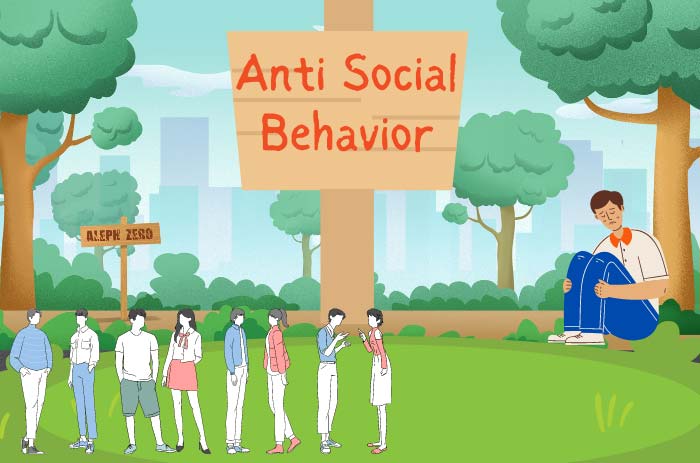Teens go through major physical, emotional, and cognitive changes during adolescence, which define their identities and behaviors. Most teenagers have good social connections and positive coping methods, but some may demonstrate behaviors that alarm parents, educators, and society. Teenage antisocial behavior involves many disruptive activities, attitudes, and feelings.
This article examines what is antisocial behavior in teens, its origins, warning indicators, and early intervention and assistance. Understanding and addressing this phenomenon is vital for creating a supportive atmosphere that encourages teenagers to form positive relationships and make positive choices during this critical phase of their lives.

What is Antisocial Behavior?
Actions or behaviors that go against society’s expectations, laws, or ideals are referred to as antisocial behavior. A wide variety of actions that are detrimental to oneself, others, and society as a whole fall under this umbrella phrase. So if you are wondering what is classed as antisocial behavior, Here are some examples:
Aggression: Aggression can take many forms, including physical assault, slander, and peer pressure. Using physical force, such as blows, kicks, pushes, or threats.
Criminal behavior: Acts of stealing, vandalism, and drug usage are all examples of criminal activity. Theft of property or entry into an unoccupied building is two such examples.
Deceitfulness: Adopting a dishonest attitude, such as lying, cheating, or stealing. Such behaviors include stealing money from a person or lying about one’s qualifications to acquire a job.
Impulsivity: Acting hastily, without giving any thought to the results, is an example of impulsivity. Examples of dangerous behavior include speeding or having sexual encounters with strangers.
Lack of empathy: Negligent or uncaring behavior toward the emotions and needs of others is an example of a lack of empathy. For instance, being indifferent to other people’s feelings.
Intimidation: Using threats or intimidation to get one’s way is an example of intimidation. For instance, threatening someone with violence or using aggressive body language to intimidate them.
Substance abuse: Abuse of drugs or alcohol is one form of substance abuse. One such activity is excessive drinking, which can lead to a loss of control over one’s actions.
Both the individual and society as a whole might suffer as a result of antisocial behavior. Isolation, trouble with the law, and strained interpersonal connections are all possible outcomes. Early intervention is key in reducing antisocial behavior and its negative consequences.
3 types of antisocial behavior
There are three primary categories of antisocial behavior:
1- Proactive aggression
Aggression that is planned and carried out with a specific end in mind is called proactive aggression. Proactively aggressive people take the initiative to achieve what they want and aren’t afraid to use harmful tactics like bullying, manipulation, or coercion to get it. They may lack empathy and be preoccupied with their own wants and needs to the exclusion of everyone else’s.
2- Reactive aggression
Aggression that is not planned and is motivated by strong feelings is called reactive aggression. Those who suffer from reactive aggression are more likely to act violently in reaction to provocation or perceived threat. They may have trouble controlling their feelings and act out violently when they become frustrated or angry.
3- Non-physical aggression
Aggression that does not require the use of physical force is called “non-physical aggression,” and it can be just as harmful to others as physical violence. Some kinds of relational violence are the spreading of rumors or gossip, social exclusion, cyberbullying, and so on. Targets of non-physical violence often have detrimental repercussions on their mental health and relationships with others.
Aggression that does not require the use of physical force is called “non-physical aggression,” and it can be just as harmful to others as physical violence. Some kinds of relational violence are the spreading of rumors or gossip, social exclusion, cyberbullying, and so on. Targets of non-physical violence often have detrimental repercussions on their mental health and relationships with others.
Manifestation of antisocial behavior in teenagers
Teens’ antisocial behavior can take many forms. The following are some typical examples:
Skipping school or dropping out: Teens who engage in antisocial behavior are more likely to miss school or drop out altogether. This could potentially limit their access to certain academic and career opportunities.
Engaging in substance abuse: Antisocial youth are more prone to try drugs and alcohol. This can lead to psychological and physiological dependence as well as legal issues.
Breaking the rules or laws: Teens that struggle with socialization may also engage in lawbreaking behaviors such as shoplifting, graffiti art, and fighting.
Engaging in risky sexual behavior: Antisocial youth are more prone to engage in sexually risky behavior, such as having sex without protection or having multiple sexual partners.
Bullying: When it comes to bullying, antisocial teens are more prone to resort to both in-person and online forms of aggression. Psychological and emotional distress may be experienced by both the offender and the victim.
Lying and deceitfulness: Adolescents who have problems socializing may resort to deception and lying to get what they want or stay out of trouble.
If you want to properly treat your adolescent’s antisocial behavior, you need to catch any indicators of danger early on.
Antisocial behavior at home
Antisocial behavior at home can cause strain and discord among family members. Some examples of common antisocial behavior at home are as follows:
Aggression: Aggression can manifest itself physically (by hitting, pushing, or hurling an object) or verbally (via yelling, shaming, or threatening).
Breaking household rules: Disobeying the house rules, such as staying out late without permission, not completing chores, or abusing substances, are all indications of antisocial behavior.
Destroying property: Destruction of property may involve damaging furniture, appliances, and personal objects.
Stealing: One form of antisocial behavior is theft, which might involve taking money or other valuables from loved ones.
Manipulation: To achieve their goals, antisocial people may resort to manipulating their loved ones by, for instance, making them feel guilty or using emotional coercion.
Withdrawing or isolating: Refusing to spend time with family members or take part in family activities is another prevalent sign of antisocial conduct at home.
The emotional and mental health of family members can be negatively impacted by antisocial behavior at home. Intervention at an early stage is essential for mitigating the problem’s impact. Family therapy or counselling can be helpful when behavioral issues stem from communication or mental health issues.
Antisocial behavior at school
When students engage in antisocial behavior at school, it can have repercussions for themselves, their peers, and the school as a whole. Here are some typical forms of disruptive student behavior:
Bullying: This includes physical, verbal, and cyberbullying, which can cause emotional and psychological damage to the victim.
Disruptive behavior: Disruptive students may engage in behaviors such as talking back to teachers, talking during class, or refusing to obey classroom norms
Cheating: Exam deception and assignment plagiarism are also examples of antisocial behavior.
Skipping school: Regular absences from school or class is a symptom of antisocial behavior and have been linked to worse academic achievement and fewer opportunities in later life.
Substance abuse: Antisocial behavior can also include the use of drugs or alcohol on school property, both of which can have serious consequences for the student’s health and the school’s reputation.
Stealing: Antisocial students may steal from their peers or the school, which can lead to broken items and a deteriorating community.
Lying: One form of antisocial behavior is lying, which can damage a person’s reputation and trustworthiness in the eyes of adults.
Discipline, suspension, or expulsion for antisocial behavior in school can have lasting effects on a student’s ability to succeed academically and professionally. Counselling, peer mediation, and other forms of behavior management should be implemented early on to combat antisocial conduct in the classroom. Collaboration between educators, school leaders, and parents helps foster a welcoming and secure classroom for all students.
Antisocial behavior in social settings
Antisocial behavior in group settings can cause tension, disagreement, and a generally unpleasant atmosphere. The following are some frequent forms of antisocial behavior seen in social contexts:
Aggression: Aggression can take the form of either physical contact (fighting, punching, or pushing) or verbal contact (yelling, shaming, threatening).
Disrespect: Antisocial people may treat others poorly in social situations, such as by talking over others, interrupting them, or making insulting comments.
Excessive drinking or drug use: Disproportionate use of alcohol or drugs is one form of antisocial conduct that can negatively impact health, the law, and personal relationships.
Breaking social norms: Rejecting social cues, invading personal space, and rejecting cultural practices are all examples of social norms that antisocial people may break.
Manipulation: Antisocial people may use social manipulation techniques like making others feel guilty or emotional blackmail to achieve what they want from others.
Disregard for others’ safety: Antisocial people may ignore the safety of others in social situations, for as through drinking and driving or by encouraging dangerous behavior.
When people act aggressively toward one another in public, it can have negative repercussions for everyone involved. Setting limits, enforcing penalties, and fostering open and honest communication are all effective ways to deal with this kind of conduct from the get-go. Substance abuse and mental health problems are two examples of underlying concerns that could be helped by counselling and treatment to reduce antisocial behavior.
Teenage limited vs. persistent antisocial behavior
There are two distinct forms of antisocial conduct that can emerge in adolescents: limited antisocial behavior and persistent antisocial behavior.
i. Limited antisocial behavior
The term “teenage limited antisocial behavior” is used to describe antisocial tendencies that emerge throughout adolescence but go away once the affected person reaches maturity. Peer pressure, stress, and other external or societal causes often lead to this kind of conduct. Limited antisocial conduct in adolescents can include things like school absences, drug and alcohol experimentation, and minor criminal crimes like shoplifting.
ii. Persistent antisocial behavior
In contrast, the more serious and long-lasting pattern of behavior known as persistent antisocial behavior generally begins in childhood and persists into adulthood. Individuals with chronic antisocial behavior are at a higher risk of committing significant acts of delinquency, including stealing, vandalism, and violence. They may also have trouble building healthy relationships and show disrespect for the rights and safety of others.
In most cases, antisocial conduct in adolescents subsides on its own, but when it persists, professional help is necessary to prevent future damage. Treating mental health or behavioral difficulties may involve counselling, therapy, or medication. Preventing future harm to the individual and those around them requires prompt attention to persistent antisocial behavior.
The severe form of antisocial behavior: conduct disorder and oppositional defiant disorder
In children and teenagers, extreme antisocial behavior can take the form of conduct disorder or oppositional defiant disorder.
i. Conduct disorder
A continuous pattern of behavior that violates the rights of others or societal norms is indicative of the mental health condition known as conduct disorder. Aggressive or violent behavior, stealing, vandalism, and other antisocial acts are all possible manifestations of conduct disorder in children and teenagers.
They may also be manipulative or exploitative, show a lack of empathy, and be insensitive to the needs of others. Professional assistance, such as counseling and medication, is often necessary for those diagnosed with conduct disorder before the age of 18.
ii. Oppositional defiant disorder
The unpleasant, belligerent, and disobedient attitude toward adults in authority is a hallmark of oppositional defiant disorder, another mental health issue. Oppositional defiant disorder is characterized by disruptive behaviors such as arguing with adults, refusing to follow the rules, and purposely irritating or provoking others.
While frustrating, this type of conduct does not typically entail physical aggressiveness or physical violence and is, therefore, less severe than conduct disorder. The development of conduct disorder or other antisocial behaviors is a risk if the oppositional defiant disorder is not treated.
Professional help is necessary for both conduct disorder and oppositional defiant disorder in order to prevent future harm and promote healthy development. Trauma, substance abuse, and other mental health illnesses can all be treated through a combination of talk therapy, medication, and family support. Seeking care at the first signs of these conditions is crucial for preventing further damage to the affected person and their environment.
Antisocial behavior related to other psychological and psychiatric conditions
There may be underlying psychological or psychiatric issues that contribute to antisocial behavior. Here are a few examples:
Substance use disorders: Addiction to drugs or alcohol has been linked to antisocial conduct. Substance abuse can cause a person to lose control of their impulses and make poor decisions, which can lead to dangerous and antisocial behavior.
Attention-deficit/hyperactivity disorder (ADHD): Children with ADHD may engage in antisocial behavior as a result of their impulsivity, hyperactivity, and inability to exert self-control.
Borderline personality disorder: People with borderline personality disorder may have problems controlling their emotions and may act impulsively, which may lead to antisocial conduct.
Narcissistic personality disorder: Individuals with a narcissistic personality disorder may engage in antisocial behavior due to their inability to empathize with others, their manipulation of others, and their disrespect for their feelings.
Psychopathy: Individuals with a narcissistic personality disorder may engage in antisocial behavior due to their inability to empathize with others, their manipulation of others, and their disrespect for their feelings.
Depression and anxiety disorders: Although these conditions are not often linked to antisocial behavior, those who suffer from them may still engage in self-destructive actions that endanger themselves and others.
It’s worth noting that not everyone who engages in antisocial behavior also has these conditions, and not everyone who has these conditions engages in antisocial behavior. You or someone you know should get help from a mental health professional if you are having behavioral or emotional problems that are affecting your social interactions with others.
Causes of antisocial behavior in teenagers
Teenage antisocial behavior can be influenced by a number of causes, some of which are:
Genetics: Some studies have found that carriers of specific genes have a higher propensity to engage in antisocial conduct.
Family environment: Teens are more likely to engage in antisocial conduct when they are exposed to risk factors such as neglect, abuse, inconsistent discipline, or a lack of parental supervision in the home.
Peer relationships: Adolescents who hang out with delinquents may be more inclined to participate in antisocial behavior because they internalize the norms and values they observe.
School environment: Poor academic performance, chronic absenteeism, and bullying all contribute to a toxic school climate, which in turn can encourage antisocial conduct in adolescents.
Substance use: The use of drugs and alcohol can greatly increase the likelihood that one will engage in criminal activity.
Mental health issues: The likelihood of engaging in antisocial behavior is amplified in those with a history of mental health disorders, such as conduct disorder, oppositional defiant disorder, or attention deficit hyperactivity disorder.
The presence of these risk factors does not ensure that a teen will participate in antisocial behavior, but it does enhance the likelihood that they will. Adolescent antisocial behavior can be mitigated and even prevented by early intervention and prevention efforts. Supportive and loving environments and competent treatment for underlying mental health issues can also assist in lessening the likelihood of antisocial conduct.
Read also: From Isolation to Connection: Stopping Anti-Social Behavior Through Understanding.
Management of antisocial behavior in teenagers
Teenage antisocial behavior can be difficult to manage, but the following methods have proven successful in the past:
Seek professional help: Get your teen evaluated by a mental health professional, like a psychologist or psychiatrist, so that you can get an accurate diagnosis and start your child on the right course of therapy if he or she is displaying antisocial behavior.
Encourage positive behavior: Positive behavior can be encouraged through the use of positive reinforcement, clear limits, and consequences for inappropriate actions.
Address underlying issues: Take care of any mental health issues, substance abuse, or familial issues that could be triggering the antisocial conduct.
Provide structure and support: Set explicit rules and expectations, establish a consistent schedule, and provide emotional support and encouragement to your adolescent to provide structure and support.
Foster positive relationships: Encourage your adolescent to connect with friends and adults who can serve as role models for positive behavior and values.
Focus on building skills: Put your energy into helping your adolescent develop helpful social and emotional skills like empathy, problem-solving][p0[ol9, and communication so that they can better control their emotions and actions.
Consider family therapy: Think about getting your whole family into therapy together to work on your conflicts and improve your communication and bond as a unit.
Endnote
Remember that dealing with antisocial adolescent behavior can take time and that your child may need continuing help. However, many kids may overcome antisocial conduct and develop positive social and emotional skills with the correct support and intervention.
References
Halty, L., Martínez, A., Requena, C., Santos, J. M., & Ortiz, T. (2011). Psychopathy in children and teenagers: models, theories and the latest research. Revista de Neurologia, 52, S19-27. PMID: 21365599 https://pubmed.ncbi.nlm.nih.gov/21365599/
Tuvblad, C., & Beaver, K. M. (2013). Genetic and environmental influences on antisocial behavior. Journal of criminal justice, 41(5), 273. PMID: 24526799 https://pubmed.ncbi.nlm.nih.gov/24526799/
Moffitt, T. E. (2018). Male antisocial behavior in adolescence and beyond. Nature human behaviour, 2(3), 177-186. PMID: 30271880 https://pubmed.ncbi.nlm.nih.gov/30271880/
Otto, C., Kaman, A., Erhart, M., Barkmann, C., Klasen, F., Schlack, R., & Ravens-Sieberer, U. (2021). Risk and resource factors of antisocial behaviour in children and adolescents: results of the longitudinal BELLA study. Child and Adolescent Psychiatry and Mental Health, 15, 1-14. PMID: 34686200 https://pubmed.ncbi.nlm.nih.gov/34686200/
Cabrera, F. J., Herrera, A. D. R. C., Rubalcava, S. J., & Martínez, K. I. (2017). Behavior patterns of antisocial teenagers interacting with parents and peers: a longitudinal study. Frontiers in psychology, 8, 757. PMID: 28626430 https://pubmed.ncbi.nlm.nih.gov/30271880/




